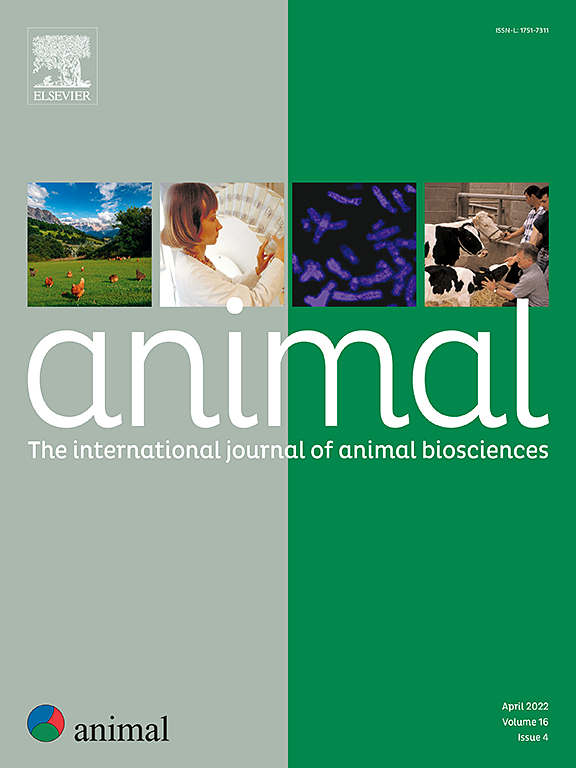Oleic acid promotes lipid accumulation in bovine adipocytes: the role of peroxisome proliferator-activated receptor alpha (PPARα) signaling
IF 4.2
2区 农林科学
Q1 AGRICULTURE, DAIRY & ANIMAL SCIENCE
引用次数: 0
Abstract
Excessive lipid mobilization due to negative energy balance in periparturient dairy cows increases their risk for diseases and decreases their productivity, highlighting the importance of enhancing energy availability during the immediate postpartum to limit negative energy balance. Oleic acid (OA) supplementation increases the energy density of the diet and holds promise in addressing metabolic challenges. In periparturient cows, OA limits lipolysis and improves adipose tissue (AT) insulin sensitivity. However, the mechanisms behind these effects are still unknown. Our objective was to characterize the effects of OA, alone and in combination with palmitic acid (PA), on lipogenic function and identify a mechanism of action in bovine adipocytes. We hypothesized that OA enhances lipid accumulation in bovine adipocytes via peroxisome proliferator-activated receptor alpha (PPARα)-dependent activation of lipogenic pathways. Pre-adipocytes were isolated from AT of Holstein dairy cows and induced to differentiate into adipocytes. Mature adipocytes were cultured with standard differentiation media (CON) supplemented with PA or OA (100, 200, and 300 µM), and mixtures of PA-OA (60-40, 50-50, and 40-60 ratios at 300 µM) for 4 or 7 d. To evaluate the effect of PPARα signaling, adipocytes were treated with or without a PPARα−specific antagonist (GW6471; 10 µM) for 7 d after induction. Compared with CON, fatty acid treatments had no effect on preadipocyte differentiation (P = 0.65). The treatments 300PA, 200OA, 300OA, 60-40, 50-50, and 40-60 increased lipid accumulation compared with CON (P < 0.0001). At d 4, 300PA and 300OA increased PPARα protein expression compared with CON (P = 0.04). PPARα inhibition decreased triglyceride levels in OA and 60-40 (P < 0.05) but not in PA (P = 0.26). Our results show a direct effect of OA supplementation on bovine adipocyte metabolism, resulting in lipid accumulation, mainly through PPARα signaling, which in turn activates lipogenic networks. Hence, providing mechanistic evidence for the use of OA, along with PA, in dairy cow diets during the periparturient period to enhance lipid accumulation and limit lipolysis. Improving energy balance will ultimately minimize health disorders and improve the production of early postpartum cows.
油酸促进牛脂肪细胞的脂质积累:过氧化物酶体增殖物激活受体α (PPARα)信号的作用
围产期奶牛由于负能量平衡导致的过度脂质动员增加了它们患病的风险,并降低了它们的生产力,因此强调了在产后立即提高能量供应以限制负能量平衡的重要性。油酸(OA)的补充增加了饮食的能量密度,并有望解决代谢方面的挑战。在围产期奶牛中,OA限制脂肪分解并改善脂肪组织(AT)胰岛素敏感性。然而,这些影响背后的机制仍然未知。我们的目的是表征OA单独和与棕榈酸(PA)联合对脂肪生成功能的影响,并确定其在牛脂肪细胞中的作用机制。我们假设OA通过过氧化物酶体增殖物激活受体α (PPARα)依赖性的脂质生成途径激活来增强牛脂肪细胞中的脂质积累。从荷斯坦奶牛AT中分离脂肪前细胞,诱导其向脂肪细胞分化。成熟脂肪细胞在标准分化培养基(CON)中添加PA或OA(100、200和300µM),以及PA-OA(60-40、50-50和40-60比例,300µM)的混合物中培养4或7天。为了评估PPARα信号传导的影响,脂肪细胞分别用或不使用PPARα特异性拮抗剂(GW6471;10µM),诱导后7 d。与对照组相比,脂肪酸处理对前脂肪细胞分化无影响(P = 0.65)。与对照组相比,300PA、200OA、300OA、60-40、50-50和40-60处理的脂肪积累增加(P <;0.0001)。第4 d,与CON相比,300PA和300OA使PPARα蛋白表达增加(P = 0.04)。抑制PPARα降低OA和60-40的甘油三酯水平(P <;P = 0.26)。我们的研究结果表明,补充OA对牛脂肪细胞代谢有直接影响,主要通过PPARα信号传导导致脂质积累,进而激活脂肪生成网络。因此,为在围产期奶牛日粮中使用OA和PA来促进脂质积累和限制脂质分解提供了机制证据。改善能量平衡最终将最大限度地减少健康失调,提高产后早期奶牛的产量。
本文章由计算机程序翻译,如有差异,请以英文原文为准。
求助全文
约1分钟内获得全文
求助全文
来源期刊

Animal
农林科学-奶制品与动物科学
CiteScore
7.50
自引率
2.80%
发文量
246
审稿时长
3 months
期刊介绍:
Editorial board
animal attracts the best research in animal biology and animal systems from across the spectrum of the agricultural, biomedical, and environmental sciences. It is the central element in an exciting collaboration between the British Society of Animal Science (BSAS), Institut National de la Recherche Agronomique (INRA) and the European Federation of Animal Science (EAAP) and represents a merging of three scientific journals: Animal Science; Animal Research; Reproduction, Nutrition, Development. animal publishes original cutting-edge research, ''hot'' topics and horizon-scanning reviews on animal-related aspects of the life sciences at the molecular, cellular, organ, whole animal and production system levels. The main subject areas include: breeding and genetics; nutrition; physiology and functional biology of systems; behaviour, health and welfare; farming systems, environmental impact and climate change; product quality, human health and well-being. Animal models and papers dealing with the integration of research between these topics and their impact on the environment and people are particularly welcome.
 求助内容:
求助内容: 应助结果提醒方式:
应助结果提醒方式:


